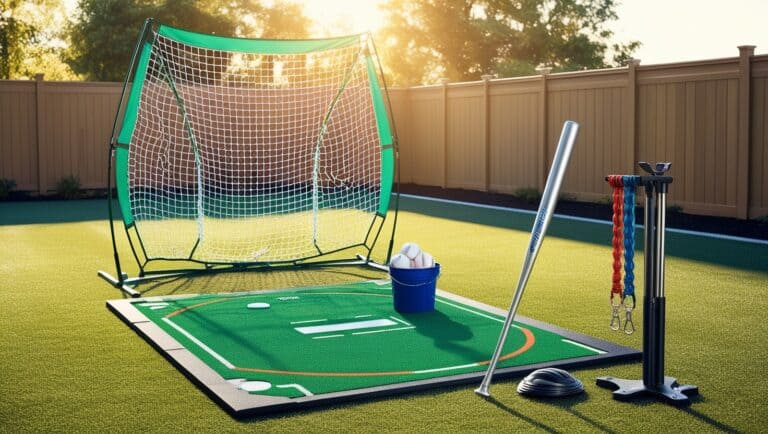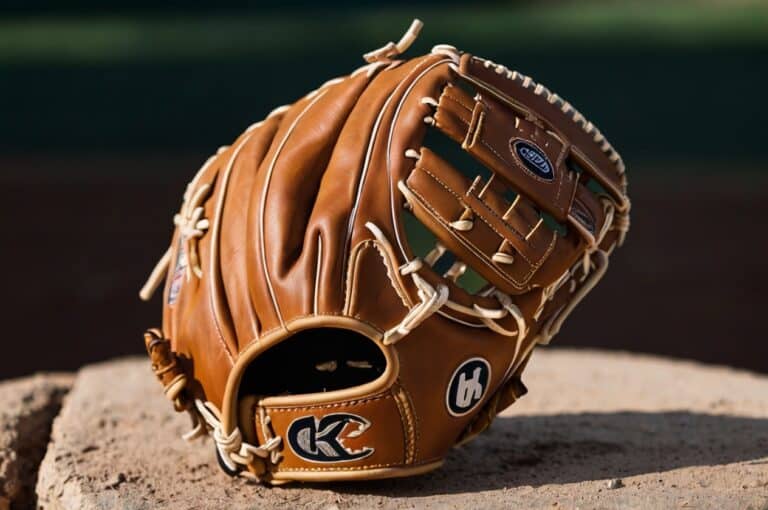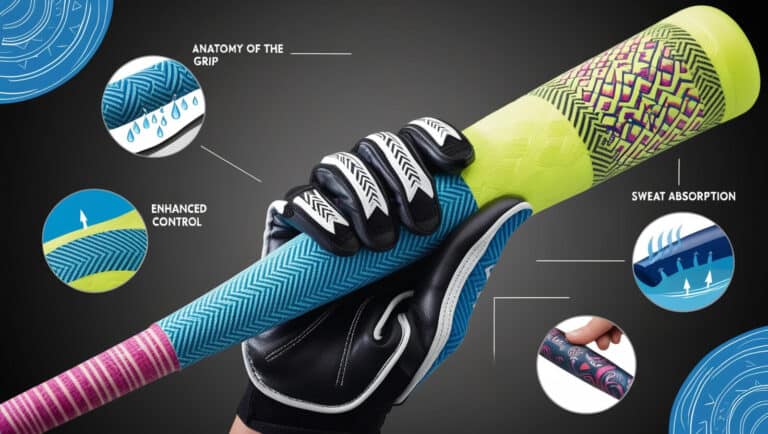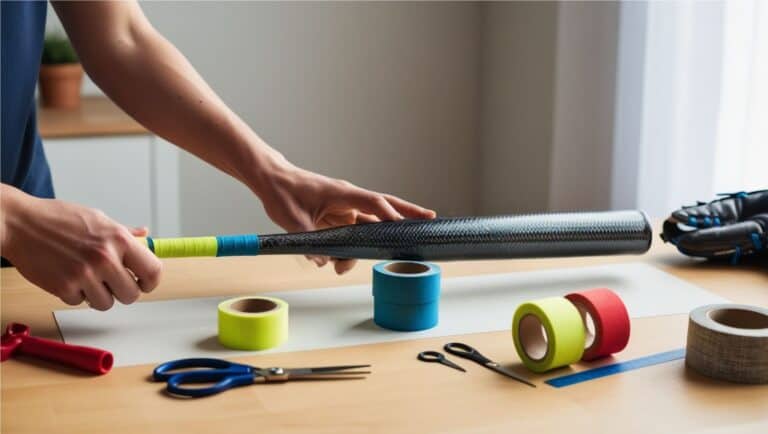Composite vs Aluminum Bats: Power Up Your Game In 2025!
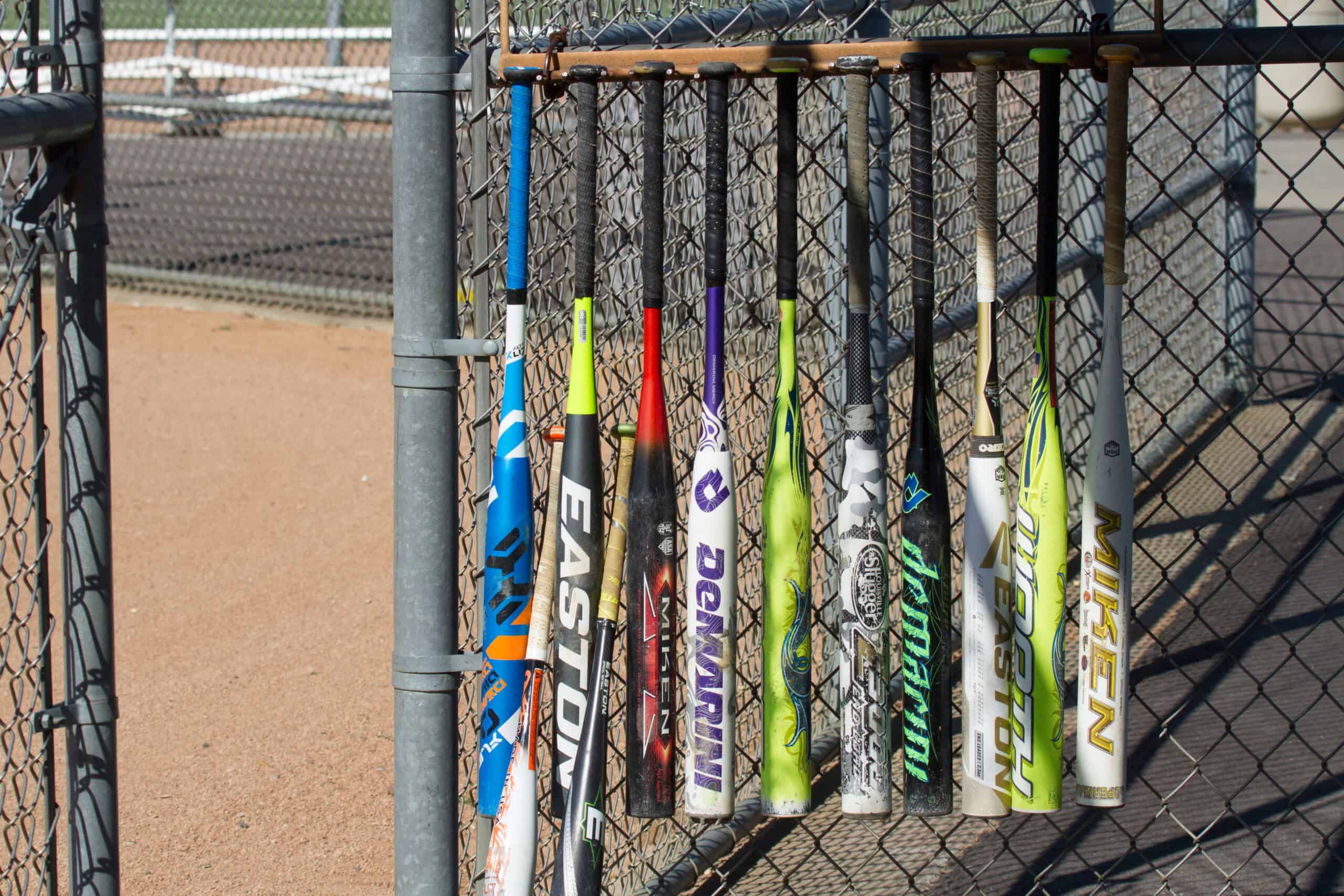
Alright, let’s kick this off with a bang! Did you know that choosing the right bat can increase your batting average by up to 20%? Picking between composite vs aluminum bats isn’t just about what feels good in your hands. It’s about giving yourself a serious edge on the field!
I’ll never forget the day I switched from my trusty old aluminum bat to my first composite. It was like going from a bicycle to a sports car! But boy, did I have a lot to learn. The world of softball bats is a lot more complex than I ever imagined.
Now, I’m not saying I’m some kind of bat guru, but after 20 years of playing slow-pitch softball (and more bat purchases than I care to admit), I’ve picked up a thing or two. And the debate between composite and aluminum bats is hotter than a dugout in July!
In this article, we’re going to break down the pros and cons of both types of bats. We’ll dive into the science behind them (don’t worry, I’ll keep it simple), share some real-world experiences, and hopefully help you make the best choice for your game. Whether you’re a power hitter looking to crush some dingers or a contact hitter trying to improve your consistency, there’s a perfect bat out there for you.
So grab a cold one, settle in, and let’s talk bats. By the time we’re done, you’ll be ready to step up to the plate with confidence, knowing you’ve got the right tool for the job. Let’s play ball!
Understanding Composite Softball Bats
When I first picked up a composite bat, I felt like I was holding a piece of space technology. These babies are a far cry from the old aluminum clunkers I started with back in the day. But what exactly makes them so special? Buckle up, folks, ’cause we’re about to dive into the world of composite bats!
First off, let’s talk materials. Composite bats are made from a mix of carbon fiber, graphite, and sometimes fiberglass. It’s like the bat equivalent of a fancy sports car – lightweight but packs a punch. When I first learned this, I couldn’t help but geek out a little. I mean, we’re using the same stuff they build aircraft with to hit softballs!
Now, here’s where it gets interesting. These bats are constructed in layers, kind of like a high-tech sandwich. This layering is what gives composite bats their unique “trampoline effect”. I remember the first time I experienced this – it felt like the ball just jumped off the bat! I thought I’d suddenly developed superhuman strength, but nope, it was just the bat doing its thing.
But here’s the kicker – composite bats need a break-in period. I learned this the hard way when I bought my first composite bat and used it in a tournament right away. My performance was… less than stellar. Turns out, you gotta give these bats some TLC before they show their true colors.
The break-in process is all about microfractures. Sounds scary, right? But it’s actually a good thing! As you hit with the bat, tiny cracks form in the barrel. This might sound like you’re damaging the bat, but you’re actually improving it! These microfractures increase the trampoline effect, giving you more pop over time.
So, how do you break in a composite bat? Well, I’ve found that about 100-150 hits usually does the trick. I like to rotate the bat slightly between hits to make sure it’s evenly broken in. Pro tip: use real game balls for this, not batting cage balls. Trust me, it makes a difference.
One thing that threw me for a loop when I first started using composite bats was the sound. If you’re used to the “ping” of aluminum, the thud of a composite might make you think you’re not hitting it right. But don’t worry, that’s just how they sound!
Now, let’s talk about the “sweet spot”. With composite bats, it’s more like a “sweet zone”. These bats typically have a larger area where you can make solid contact, which is a godsend for man of us who don’t always hit the ball perfectly every time, me included. I can’t tell you how many times this has saved me in clutch situations.
But here’s something to watch out for – temperature matters with these bats. Extreme heat can mess with the resin that holds the fibers together. On the flip side, using a composite bat in cold weather under 45 degrees Fahrenheit can potentially damage the bat due to the increased density of the softball leading to dents and cracks.
Composite bats are high-tech, they need some breaking in, and they can be a bit temperamental with temperature. But when you get it right? Man, there’s nothing quite like the feeling of crushing a ball with a well-broken-in composite bat. It’s enough to make you feel like a softball superhero!
The Advantages of Composite Softball Bats
Boy, oh boy, do I have some stories about the advantages of composite bats! When I first made the switch from aluminum, it was like I’d been given superpowers. The ball just jumps off the bat!
First off, let’s talk about the sweet spot. Or should I say, sweet zone? With composite bats, it’s like the softball gods decided to be a little more forgiving. The sweet spot on these babies is huge compared to aluminum bats. I remember the first time I realized this – I hit what I thought was a mishit, but the ball went way farther than I expected. It was like the bat was saying, “I got you, buddy.”
And speaking of mishits, let me tell you about the reduced vibration. Remember that stinging feeling in your hands when you hit the ball off the end of an aluminum bat? Ouch!! This is exactly why I wear batting gloves today along with using composite bats. With composites, the vibration is pretty much a thing of the past. I used to dread those cold early-season games where every hit felt like I was high-fiving a jackhammer. Now? It’s smooth sailing, even when I don’t quite catch it right.
Here’s another thing I love about composite bats – the weight distribution. These bats are typically more end-loaded, which means more weight in the barrel. Now, you might think that’d make them harder to swing, but it’s actually the opposite. It’s all about the physics, my friends! This weight distribution lets you generate more bat speed, which means more power. I’m no scientist, but I know that when I swing a well-balanced composite bat, it feels like I’m wielding Thor’s hammer out there.
But wait, there’s more! (I sound like an infomercial, don’t I?) One of the coolest things about composite bats is that they’re customizable. You can buy them in a variety of configurations from being end-loaded to mid-loaded, etc. You just need to try a few to understand what works best for your swing. How cool is that?
Now, I gotta be honest – all these advantages come at a price. Composite bats are usually more expensive than their aluminum counterparts in the $300 range. But in my experience? Totally worth it. It’s an investment in your game.
So there you have it! The big sweet spot, reduced vibration, better weight distribution, and customizable performance – these are the superpowers that composite bats can give you. Just remember, with great power comes great responsibility. And by responsibility, I mean the responsibility to crush some home runs!
Check out some of the hottest composite bats from Dicks Sporting Goods below!
The Drawbacks of Composite Softball Bats
Now, I know I’ve been singing the praises of composite bats, but let’s get real for a second. These high-tech wonders aren’t without their downsides.
First up, let’s talk about cost. Hoo boy, these babies can put a dent in your wallet faster than you can put a dent in a softball. Is it worth it? For me, absolutely. But if you’re on a tight budget, it’s definitely something to think about.
Now, let’s chat about durability. Composite bats can be a bit… temperamental. Extreme heat can mess with the resin that holds the fibers together. On the flip side, using a composite bat in cold weather can potentially dent the bat, not fun, trust me.
Speaking of temperature sensitivity, let’s talk about cold weather performance. If you play in a climate where it gets chilly like mine in Minnesota in the Midwest, composite bats might not be your best friend early in the season. I once played in an early season game where it was so cold, I could see my breath. My composite bat felt like I was swinging a frozen fish! The ball just wouldn’t come off the bat with any zip. Meanwhile, my buddy with his aluminum bat was crushing it.
Another thing to keep in mind is the potential for cracking or breaking over time. Now, don’t get me wrong, these bats are tough. But they’re not indestructible. I’ve seen more than a few composite bats meet their maker after one too many powerful hits. There’s nothing quite like the heartbreak of hearing that telltale ‘crack’ – and I don’t mean the sound of the ball being hit.
Let’s not forget about the break-in period. When you first get a composite bat, it’s not going to perform at its best right away. It needs time to “warm up” – usually about 100-150 hits. If you use a brand new composite bat in a game don’t expect to be crushing the ball initially. It’s like the bat is saying to you, “Nah, bro, I’m not ready yet.”
Lastly, there’s the issue of regulations. Some leagues have restrictions on composite bats due to their performance advantages. I once showed up to a tournament, all excited to use my new composite bat, only to find out it wasn’t allowed. Talk about a buzzkill! Pro-Tip: Make sure to check your local league or tournaments guidelines to ensure your bat is legal before buying one.
The dark side of composite bats – the cost, temperature sensitivity, potential for damage, break-in period, and possible league restrictions. Don’t get me wrong, I still love my composite bats. But it’s important to go in with your eyes open. After all, knowledge is power – both on and off the field!
Exploring Aluminum Softball Bats
Alright, friends, let’s talk about good ol’ aluminum bats. These are the classic workhorses of the softball world, and they’ve been around longer than I’ve been playing – which is saying something!
When I first started playing slow-pitch softball, aluminum bats were pretty much all we had. I remember my first one – it was an Easton that I thought was the coolest thing ever. Little did I know, there was a whole world of aluminum bat tech that I was about to discover.
So, what exactly are these bats made of? Well, it’s not just plain old aluminum like a soda can. We’re talking about high-grade aluminum alloys here.
Now, let’s talk construction. You’ve got your one-piece bats and your multi-piece bats. One-piece bats are exactly what they sound like – the whole thing is made from a single piece of aluminum. These babies are stiff and can pack a punch, but they’re not for the faint of heart. I remember the first time I mishit with a one-piece – my hands were buzzing for the next three innings! Pro-Tip: Batting gloves help a ton at reducing vibration from a mishit.
Multi-piece bats, on the other hand, usually have a separate handle and barrel. These are a bit more forgiving on the hands, which is great for weekend warriors who don’t like using batting gloves.
Here’s where it gets really interesting – alloy variations. Different companies use different alloys, and let me tell you, it can make a big difference. Some alloys are designed for durability, others for performance. I once had a bat made with some high-tech alloy that the manufacturer claimed would “revolutionize” the game. Did it? Well, let’s just say I’m not playing in the pros, but it sure felt good to swing!
One thing I’ve noticed over the years is how the “ping” sound has changed. Back in the day, aluminum bats had this sharp, high-pitched ping that you could hear across the field. Nowadays, with these advanced alloys, some bats have a deeper, more muted sound. It’s not quite the “thunk” of a composite, but it’s getting there.
Oh, and let’s not forget about the walls of these bats. Single-wall or double-wall configurations are the most common. Each wall configuration affects the trampoline effect differently. The more layers the more the ball just explodes off the bat!
The world of aluminum bats in all its pinging, alloy-mixing, multi-walled glory. They might not be as flashy as their composite cousins, but there’s a reason these bats have stood the test of time. In the next section, we’ll dive into the specific benefits of these metallic marvels. Stay tuned!
Benefits of Aluminum Softball Bats
Now, don’t let all that fancy composite talk fool you – aluminum bats have some serious perks that keep players coming back to them year after year. I’ve swung my fair share of both, and let me tell you, there’s still a lot to love about good ol’ aluminum.
First off, let’s talk about that sweet, sweet instant gratification. You know how I mentioned earlier that composite bats need a break-in period? Well, aluminum bats are ready to rock straight out of the wrapper. I remember the first time I bought a new aluminum bat – I went straight from the store to the field and started crushing balls like I was in the Home Run Derby. No waiting, no carefully counting hits, just pure, immediate performance!
Another huge plus? Consistency. Aluminum bats are like that reliable friend who’s always there for you, rain or shine. Hot day? No problem. Cold night game? Bring it on. These bats perform around the same regardless of the temperature.
Now, let’s talk money. If you’re balling on a budget (see what I did there?), aluminum bats are your best friend. They’re generally cheaper than composite bats, which means more cash left over for post-game celebrations. Or, you know, responsible adult things. But mostly celebrations.
Durability is another big win for aluminum. These bats can take a beating and keep on swinging. I’ve got an old aluminum bat that’s been with me for years. It’s got more scratches than my first car, but it still hits like a dream.
Let’s not forget about that classic “ping” sound. Sure, some players prefer the thud of a composite, but nothing beats the satisfying ping of a well-struck ball off an aluminum bat. It’s music to my ears! Plus, it’s great for intimidating the opposing team. Nothing says “I mean business” like the echo of that ping across the field.
Lastly, there’s the issue of league regulations. Some leagues have restrictions on composite bats due to their performance advantages. With an aluminum bat, you’re pretty much always in the clear. No worries about showing up to a game and finding out your bat isn’t allowed. Been there, done that, not fun.
Aluminum bas equal, instant performance, consistency in all weather, affordability, durability, the classic “ping” sound, and fewer regulatory headaches – these are the badges of honor that aluminum bats wear proudly. They might not have all the high-tech flash of composites, but sometimes, the old ways are the best ways. Now, who’s ready to hear that ping?
Check out some of the hottest aluminum bats from Dicks Sporting Goods below!
Disadvantages of Aluminum Softball Bats
We’ve sung the praises of aluminum bats, but it’s time to talk about some of the cons. These trusty metal sticks aren’t all sunshine and home runs. They’ve got their downsides too!
First up, let’s talk about the sweet spot – or should I say, the not-so-sweet spot. Compared to composite bats, the sweet spot on aluminum bats is smaller than a postage stamp. Okay, that’s an exaggeration, but you get the idea. With aluminum, you really need to make contact in just the right spot to get that satisfying hit. Miss by a little, and your hands might be hurting for a few innings.
Now, let’s chat about vibration. Oh boy, the vibration. If you’ve ever hit a ball off the end of an aluminum bat on a cold day, you know exactly what I’m talking about. That sting that travels up your arms and makes your hands feel like they’ve been zapped by lightning? Yeah, that’s a special kind of pain reserved for aluminum bat mishits. Not fun, not fun at all.
Let’s not forget about customization – or rather, the lack thereof. With composite bats, you get to pick different kinds of swing weight configurations but with aluminum bats you usually are only able to get a balanced swing weight which might not work the best for your swing. Also with aluminum bats what you see is what you get! There’s no magical break-in period that’s going to suddenly make your bat perform better.
And then there’s the issue of power. Don’t get me wrong, you can absolutely crush balls with an aluminum bat. But compared to a well-broken-in composite? It’s like comparing a firecracker to dynamite. I’ll never forget the first time I hit with a high-end composite after years of using aluminum. I thought I had suddenly developed superhuman strength!
Lastly, let’s talk about feel. This one’s a bit subjective, but many players (myself included) find that aluminum bats just don’t have the same satisfying feel on contact as composites. It’s hard to describe, but it’s like the difference between slicing through butter and chopping through a block of ice. Both’ll get the job done, but one just feels so much smoother.
So there you have it, my friends! The dark side of aluminum bats – smaller sweet spot, more vibration on mishits, lack of customization, less power, and a different feel on contact. Are these dealbreakers? Not necessarily. But they’re definitely things to keep in mind when you’re choosing your weapon of choice. Remember, the best bat is the one that feels right in your hands – whether it’s aluminum, composite, or a oversized plastic souvenir bat from the gift shop. (Okay, maybe not that last one.)
Performance Comparison: Composite vs Aluminum Bats
It’s time for the main event! We’re putting composite and aluminum bats head-to-head in a performance showdown. I’ve swung both types for years, and this comparison is tighter than a one-run game in the bottom of the 7th.
Let’s start with exit velocity and distance potential. In my experience, a well-broken-in composite bat usually has the edge here. I remember the first time I really connected with a composite – that ball took off like it had a jetpack and I suddenly discovered real power. But don’t count aluminum out. A good aluminum bat can still send balls into orbit, especially if you’re a power hitter. I’ve seen plenty of dingers crushed with aluminum bats that would make any composite user jealous.
Now, consistency is where things get interesting. Aluminum bats are like that reliable old truck that starts up every time, no matter the weather. They perform pretty much the same from day one until the day it finally retires. Composites, on the other hand, are more like a fine wine – they get better with age (up to a point). The flip side? Once a composite starts to go, it goes fast. It’s like one day you’re crushing balls, and the next, nothing goes as far as it used to.
Let’s talk about bat speed and control. This is where personal preference really comes into play. Generally speaking, composite bats allow for faster swing speeds due to their weight distribution. But here’s the catch: some players feel they have better control with aluminum bats. The stiffness of aluminum can provide a more direct transfer of energy, which some hitters love.
Now, let’s get into the nitty-gritty of player feedback and preferences. In my leagues, it seems like the power hitters tend to gravitate towards composites, while contact hitters often stick with aluminum. But it’s not a hard and fast rule. I’ve seen plenty of exceptions and a lot depends on a person’s budget.
Temperature is another factor to consider. I played in a tournament once where the temperature dropped about 30 degrees between the first and last game. My composite bat felt great in the warm afternoon sun, but by the chilly evening game, it just didn’t have the pop! My teammate with his aluminum bat? Didn’t miss a beat.
At the end of the day, the performance difference between composite and aluminum often comes down to the individual player. It’s like choosing between a sports car and a pickup truck – they’ll both get you where you’re going, but the ride will be different. Some players mash with composites, others swear by aluminum.
The key is to try both types and see what works best for you. Your swing, your strength, your hitting style – all these factors play into which type of bat will help you perform your best. And remember, the most important thing isn’t what your bat is made of, it’s how you swing it. Now, who’s ready to step up to the plate and knock one out of the park?
Making the Right Choice for Your Game

Alright, sluggers, we’ve covered a lot of ground, but now comes the million-dollar question: how do you actually choose between composite and aluminum? Well, grab your scorecards, because I’m about to break it down for you.
First things first, let’s talk about your playing style. Are you a power hitter looking to crush dingers over the fence or want more distance on hits? Or are you more of a contact hitter, focused on placement and consistency? In my experience, power hitters often lean towards composite bats for that extra pop, while contact hitters might prefer the consistency of aluminum.
Budget is another big consideration. Let’s face it, not all of us can drop top dollar on a composite bat $300 or more (no matter how much we try to convince our significant others that it’s a “necessary expense”). Aluminum bats are generally more wallet-friendly with high end bats in the $249 range but you can get a great bat for around $150, which is great if you’re just starting out or if you tend to, ahem, “accidentally” leave your bat at the field occasionally.
Don’t forget about league regulations! There’s nothing worse than showing up to a game with a shiny new bat only to find out it’s not allowed. Trust me, double check your league or tournament regulations.
Personal preference plays a huge role too. Some players love the “ping” of an aluminum bat, while others prefer the more muted “thunk” of a composite. It’s like choosing between rock and pop music – there’s no right answer, just personal taste.
Here’s a pro tip: if possible, try before you buy. Borrow bats from teammates, test them out in batting practice. I once bought a bat based solely on online reviews and ended up with something that didn’t fit my swing very well.
Lastly, consider the conditions you usually play in. If you’re in a climate with extreme temperatures, an aluminum bat might be more consistent year-round. I remember a particularly cold early season game where my composite bat felt like it was made of rubber. Meanwhile, my teammate with his aluminum bat was hitting like it was mid-July.
At the end of the day, the best bat is the one that feels right in your hands and gives you confidence at the plate. Whether that’s a composite, aluminum, or a broomstick you found in the dugout (not recommended, by the way), what matters most is how you swing it.
So there you have it, my friends! Consider your playing style, budget, league rules, personal preference, and playing conditions. Try out different bats if you can. And most importantly, have fun out there! Because whether you’re swinging composite or aluminum, the real joy is in playing the game. Now, who’s ready to play ball?
We’ve covered more ground than a center fielder chasing a deep fly ball. From the high-tech world of composite bats to the classic ping of aluminum, we’ve swung through it all. So, what’s the final score in the composite vs. aluminum game?
Truth is, there’s no clear-cut winner. Like choosing between pizza and tacos, it often comes down to personal preference (and now I’m hungry). Composite bats offer that sweet trampoline effect and a larger sweet spot, but they come with a heftier price tag and some temperamental behavior in extreme temperatures. Aluminum bats, on the other hand, give you that consistent performance and durability, but might leave you wanting more when it comes to power and vibration dampening.
Remember, the best bat for you is the one that makes you feel like a slugger every time you step up to the plate. It doesn’t matter if it’s the latest composite technology or a trusty aluminum bat that’s older than your rookie teammate – if it works for you, it works!
Now, I want to hear from you! What’s your bat of choice? Any funny stories about bat mishaps or unexpected triumphs? Drop a comment at one of our social media sites below and let’s keep this conversation going. After all, talking about softball is the next best thing to playing it!
Play ball, everyone!
Craving more softball wisdom?
Unlock game-changing tips below!

